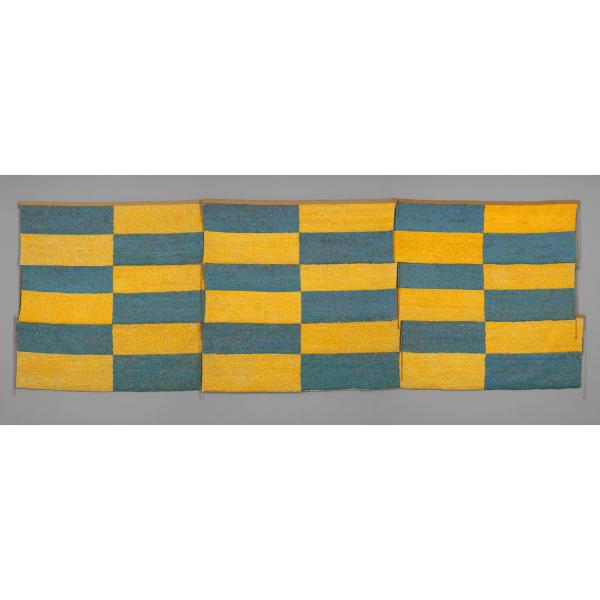Nine Feathered Panels
En 1943 fue encontrado un grupo importante de aproximadamente noventa y seis paneles de plumas en el valle de Churunga, en la costa Sur de Perú. Los paneles fueron enrollados y guardados en grandes vasijas de cerámica que luego fueron enterradas en un centro ceremonial conocido como Corral Redondo. Cada panel fue densamente cubierto con decenas de miles de plumas, principalmente plumas de guacamayo azul y amarillo, un ave que vive en la selva tropical amazónica. Las plumas fueron atadas a hilos de algodón una por una y a mano. Luego fueron cosidas a paneles lisos de tela de algodón. Es probable que estos paneles, de los cuales nueve están presentados, hayan adornado alguna vez las paredes de un edificio.
Further information
The discovery of an ancient burial or ceremonial site in the upriver region of the Churunga Valley, in far south Peru, received little attention in the turbulent world of 1943. Decades later, it would take two generations of Andean scholars to painstakingly piece together the puzzling story of this discovery, which included the largest and most spectacular find of Precolumbian Peruvian feather work to date.
Protected from decay by being rolled, placed into large ceramic jars, and buried in the arid soil, the cache included an estimated ninety-six panels, each densely covered with tens of thousands of small glossy macaw body feathers, primarily from the blue and yellow macaw (Ara ararauna). Although these panels were found in the dry western foothills of the Andes, the birds’ home is the Amazonian rainforest, far to the east. The effort required to secure such a mind-bogglingly large supply of either feathers or live birds suggests that colorful feathers were highly valued.
The panels are of roughly similar dimensions, and the majority feature alternating rectangles of blue and yellow feathers, which came from the macaw’s dorsal and ventral sides, respectively. The panels have a woven heading tape, and most also include braided cords that hang from the narrow sides. Although the cords suggest that these works were meant to be secured to some kind of structure, their actual function remains frustratingly illusive.
Christine Giuntini, Conservator, 2016
References
Bird, Junius B. 1958. Art of Ancient Peru: Selected Works from the Collection. Checklist with commentary of an exhibition at the Museum of Primitive Art, Feb 19–May 18, 1958. New York: Museum of Primitive Art. (unpaginated)
King, Heidi. 2013. "The Wari Feathered Panels from Corral Redondo, Churunga Valley: A Re-examination of Context." Ñawpa Pacha, Journal of Andean Archaeology 33 (1): 23–42.
Artwork Details
- Title: Nine Feathered Panels
- Date: 600–900 CE
- Geography: Peru, South Coast
- Culture: Wari
- Medium: Feathers on cotton, camelid hair
- Dimensions: H. 81 1/2 in. × W. 20 ft. 1 3/4 in. (207 × 614 cm)
- Classification: Textiles-Featherwork
- Credit Line: The Michael C. Rockefeller Memorial Collection, Bequest of Nelson A. Rockefeller, 1979
- Object Number: 1979.206.466–.473, .464
- Curatorial Department: The Michael C. Rockefeller Wing
Audio

1654. Feathered panels, Wari artist(s)
Arabel Fernández López
ARABEL FERNÁNDEZ LÓPEZ: You are in front of nine feather mosaic panels that have this decoration with bright blue and yellow feathers that were found in Corral Redondo.
JOSÉ MARÍA YAZPIK (NARRATOR): The artists who made this work attached strings of feathers in overlapping rows to a finely woven support textile. They created an unbroken surface of luxurious and luminous color that completely conceals the valuable cloth beneath. Archaeologist Arabel Fernández López.
ARABEL FERNÁNDEZ LÓPEZ: Approximately, they use 17,000 feathers for the decoration of one of these panels. So, you can imagine we were in front of nine panels and each panel has 17,000 feathers. They use feather from Guacamayo or Macaw birds that inhabitance is in a tropical forest.
JOSÉ MARÍA YAZPIK: The astounding quantity and origin of feathers are a testament to the vastness of the Wari empire. Corral Redondo, where the panels were unearthed, is on Peru’s south coast, far from both the eastern rainforests and the Wari highland capital.
ARABEL FERNÁNDEZ LÓPEZ: Unfortunately, we don't have scientific information about the discovery of these feather mosaic panels. The people who found this said that the panels were rolled up and put inside big urns of Wari styles. They found eight of these urns and totally they have 96 of this panel that are in different museums around the world.
JOSÉ MARÍA YAZPIK: Wari artists almost certainly created these striking panels for a special purpose, but they offer few clues to their use. Cords hanging from the panel’s corners suggest they might have been hung, yet they appear as if newly made. It is only because their ancient owners carefully stored the panels in ceramic urns on Peru’s arid coast that we are able to witness their undeniable splendor today.
More Artwork
Research Resources
The Met provides unparalleled resources for research and welcomes an international community of students and scholars. The Met's Open Access API is where creators and researchers can connect to the The Met collection. Open Access data and public domain images are available for unrestricted commercial and noncommercial use without permission or fee.
To request images under copyright and other restrictions, please use this Image Request form.
Feedback
We continue to research and examine historical and cultural context for objects in The Met collection. If you have comments or questions about this object record, please contact us using the form below. The Museum looks forward to receiving your comments.